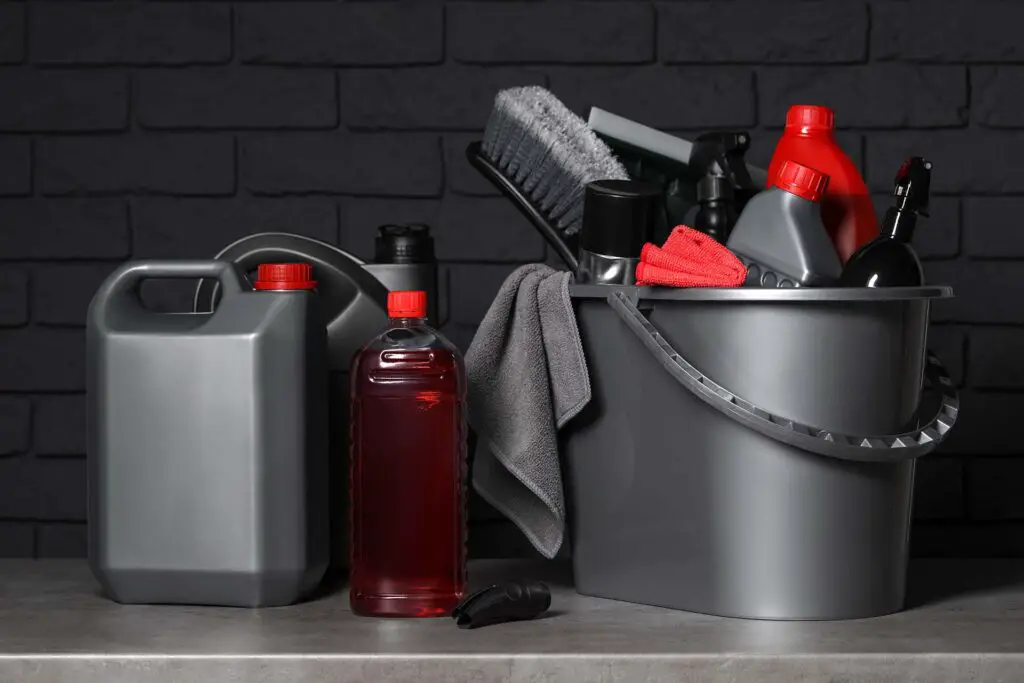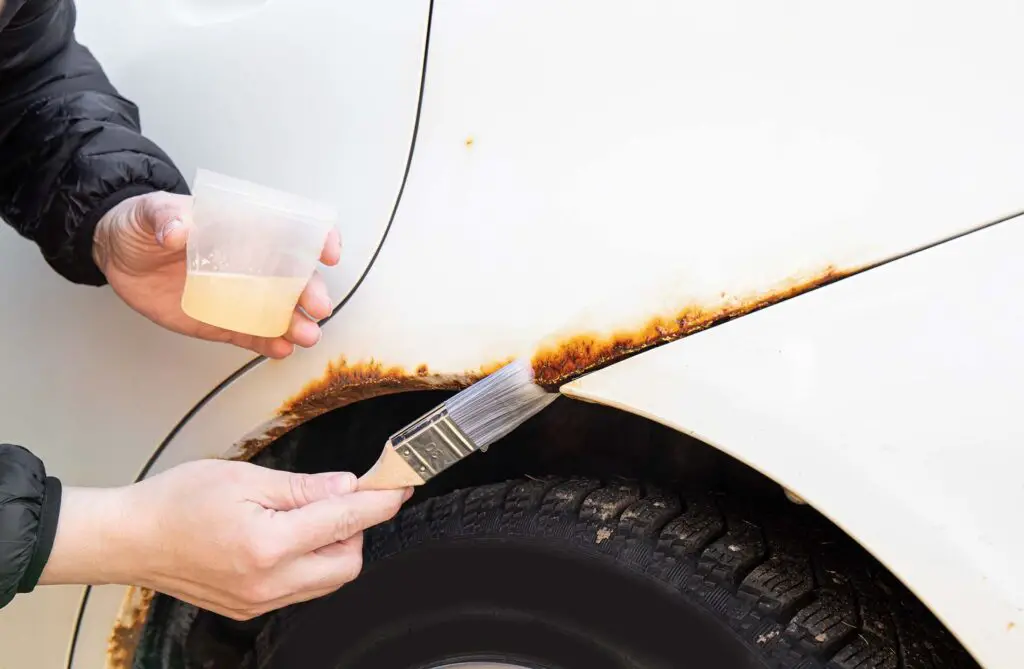There’s an old-age battle between drivers and that pesky enemy called corrosion. If you’re experiencing this nuisance yourself, learning how to fix rust on your car and tackle this problem head-on is the best possible solution. Here’s a comprehensive guide that will take you through each step.
Start by cleaning the affected area, followed by detailed sanding and rust treatment. After prepping the surface, apply a primer, followed by matching paint and a protective clear coat. Finish with polishing to blend the newly treated area. Preventative measures, like regular car washes and quality wax applications, can help avoid future issues.
Why Does Rust Form on a Vehicle?
Cars are exposed to various elements. Whether you’re spending your days stuck in stop-and-go traffic in one of the cities with the worst drivers or cruising down the famous US routes.
From moisture to road salts, these outside elements can compromise the metal’s integrity over time. It’s all chemistry at play, with moisture and metals leading to oxidation, eventually spreading this unwanted vehicle “disease.”

Different Types of Rust and Their Severity
Your car’s situation can range from a mere cosmetic annoyance to something far more alarming that affects the structure of your vehicle. So, first and foremost, let’s delve into the different scenarios to know what you’re dealing with:
Surface Rust – A Superficial Layer on the Topcoat
This type is what you might call a “skin-deep” problem. It’s mostly a cosmetic issue, often forming scratches or nicks in the vehicle’s paintwork. Think of it as a little blemish on your car’s otherwise pristine surface. With the right tools and some elbow grease, surface rust can typically be addressed without too much hassle.
Scale Rust – Penetrates Deeper, Affecting the Metal
Now, things are getting a bit more serious. Scale corrosion doesn’t just settle on the surface but pushes its way down, compromising the strength of the metal beneath your paint. It can lead to more significant damage if not addressed, so it’s essential to be proactive in your approach.
Penetrating Rust – Severe Rust That Creates Holes in the Metal
The most severe of the bunch, penetrating rust, is bad news. It eats its way through the metal, leading to holes and substantial structural issues. At this stage, your vehicle’s safety can be compromised. Fixing this level of decay often requires costly repairs and sometimes even complete replacement.
Tools and Materials You’ll Need to Deal With the Corrosion
When preparing for a showdown with that pesky corrosion, it’s essential to come armed and ready. Below is a quick arsenal checklist that’ll make sure you have the upper hand in this battle:
| Tools/Materials | Purpose |
| Sandpaper | To smooth the surface and remove superficial corrosion |
| Rust converter or remover | To treat and convert rusted areas or eliminate them |
| Primer | Prepares the metal surface for painting |
| Auto body paint | Restores the car’s color after treating rusted areas |
| Clear coat | Seals and protects the paint from external elements |
| Masking tape and sheeting | Protects unaffected areas during the repair process |
There Are Plenty of Specialized Products Available
The auto repair market is flooded with a plethora of specialized products designed for this issue. Removers such as the Chemical Guys Heavy Metal Polish Restorer and Protectant are formulated to stop the corrosion process and prepare the metal for painting.
Similarly, primers are essential – they serve as an intermediary layer that ensures your paint adheres well and looks smooth. I personally recommend the Rust-Oleum Professional Primer Spray Paint, as it’s easy to apply and does the job well. Remember, the right products can make all the difference in the quality and longevity of your repair.
Don’t Overlook the Safety Equipment
Before diving into the task at hand, prioritizing your safety is a must. While working on removal and repair, you’re exposing yourself to chemicals, dust, and debris. This is why gloves, goggles, and a dust mask should be your trusty sidekicks. Moreover, always ensure you’re working in a well-ventilated space. The last thing you want is to be breathing in fumes or dust that could pose health hazards.

How to Fix Rust on Your Car – A Step-By-Step Guide
So, you’ve got some pesky spots making your four-wheeler look a tad older than it should? Don’t worry – with a bit of elbow grease and some know-how on how to fix rust spots on a car. You can have your ride looking spick and span in no time.
Preparing the Affected Area
Before diving into the actual repair, it’s crucial to prep your workspace. Begin by cleaning the compromised area with a mix of soapy water, making sure to get rid of any dirt or debris. Once you’ve cleaned it up, give it ample time to dry out.
To safeguard the unaffected parts of your four-wheeler from any accidental scuffs or paint splatters, reach for some masking tape and plastic sheeting. Only once this is complete and the area is completely dried out you can continue with the task.

Sanding the Area and Applying the Rust Converter or Remover
Here’s a step-by-step breakdown of the repair process:
- Begin by targeting the affected area using a coarse sandpaper,
- Once you’ve got the majority of the corroded material off, progress to finer grits of sandpaper,
- If the corrosion has dug its heels deep into the metal, consider using a grinding tool,
- Before applying any product, make sure to rid the area of all dust and debris,
- Following the product’s guidelines, coat the sanded area with your chosen converter or remover,
- Make sure the product covers all compromised spots for an effective treatment,
- Allow the converter or remover to set for the recommended duration specified on the product instructions.
Priming, Painting, and Polishing for a Seamless Finish
Post-treatment, the game is all about aesthetics. Start with a light coat of primer on the sanded area, letting it dry as indicated. Then, with an artist’s precision, paint over the prepared surface using a hue identical to your car’s shade. To ensure the freshly painted section stays glossy and guarded, a clear coat application will do the trick.
Patience is key here – let each layer set and dry completely before moving on to the next step. And the final touch? Gently buff the repaired zone, making sure it seamlessly blends with the car’s original paint, giving your vehicle that brand-new look once again.

How to Prevent Rust From Forming in the Future
Now that you know how to fix a rust spot on a car, maintaining its pristine condition is the next mission. Here are some proactive measures you can adopt to keep corrosion at bay:
Regularly Washing Your Car
Dirt, grime, and contaminants can, over time, eat away at your car’s paint, exposing the metal beneath. Washing your car regularly, especially after off-road driving in muddy or salty conditions, helps remove these corrosive elements.
Applying a Quality Wax
By applying a high-quality wax after washing at least twice a year, you’re giving your vehicle an extra layer of defense against potential corroding agents. I personally recommend the Chemical Guys Butter Wet Wax, as it can work wonders and give your precious ride that extra shine.
Checking and Cleaning Drain Holes
Vehicles come equipped with drainage holes, primarily when it comes to doors and other areas. Over time, these can get clogged with debris, leading to water buildup. Regularly checking and clearing them ensures water doesn’t sit and starts compromising the metal.
Being Mindful of Where You Store the Car
It’s always a good idea to store your car in a garage or under a carport, away from direct exposure to harsh weather elements. If that’s not possible, consider using a high-quality car cover to shield it from moisture and contaminants.
Parking Away from Sprinklers
Water from sprinklers can be harsh on your car’s paint due to minerals or chemicals present. Constant exposure can slowly degrade the paint, leading to potential spots where corrosion can set in. So, make sure you steer clear of sprinklers whenever you can.
When to Seek Professional Help
There’s a lot of satisfaction in DIY projects, but it’s crucial to recognize when the damage might be out of one’s league. Addressing minor wear and tear on your own is commendable, but some issues need a seasoned hand:
- When the corrosion has created extensive damage,
- When you’re unsure about how to fix rust holes on a car,
- If the affected area is in a critical structural spot on the vehicle.
Not only do professional mechanics possess the expertise and tools for a seamless repair, but they also offer specialized rustproofing and undercoating services. These protective measures form a robust shield against future wear and tear, ensuring the longevity of your cherished ride.

Keeping That Shine, Minus the Decay
In the grand scheme of things, corrosion can feel like a pesky speed bump. But as we’ve explored, with the right tools and a bit of patience, you can keep your ride looking pristine. After all, a four-wheeler is more than just a machine – it’s a companion on countless adventures. So, let’s keep it shining, road-ready, and free from unwanted decay!
FAQ
Can I Use Household Items to Combat Corrosion on My Car?
While some DIY enthusiasts swear by household items like baking soda or vinegar to tackle minor corrosion, these methods aren’t as effective or long-lasting as specialized products. It’s always best to use products designed for auto bodywork to ensure optimal results and protect your car’s finish.
How Does Saltwater Affect My Car’s Exterior?
Saltwater accelerates the corrosion process, especially in areas with chips or scratches in the paint. If you live near the coast or drive on salted roads during winter, it’s crucial to wash your car regularly to prevent salt buildup and potential damage.
Do Newer Cars Still Have Problems With Corrosion?
While modern vehicles are designed with better rust prevention in mind, using galvanized steel or corrosion-resistant coatings, no car is entirely immune. Factors like environmental conditions, paint chips, or dings can still make newer cars susceptible over time. Regular maintenance remains key.








